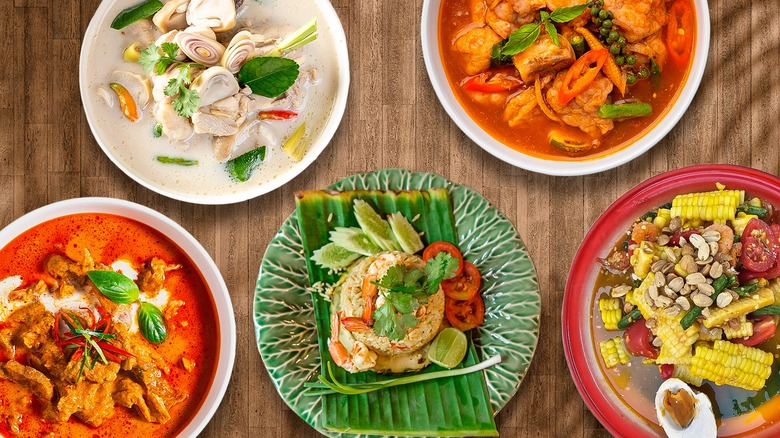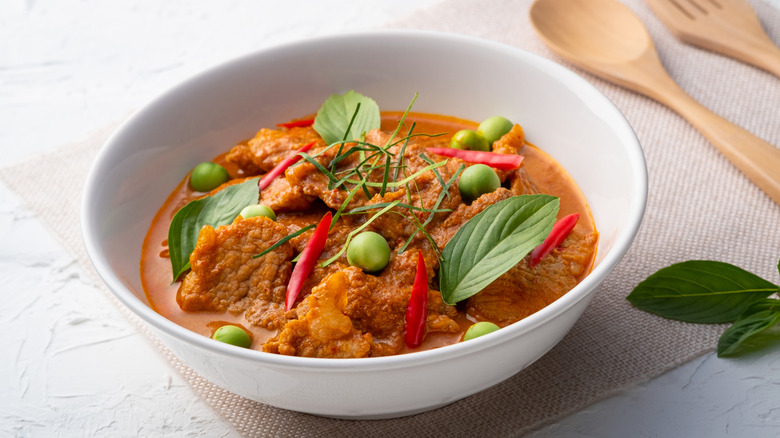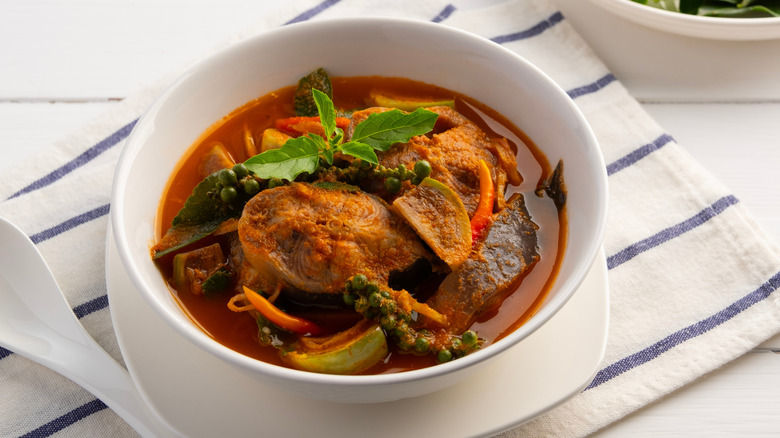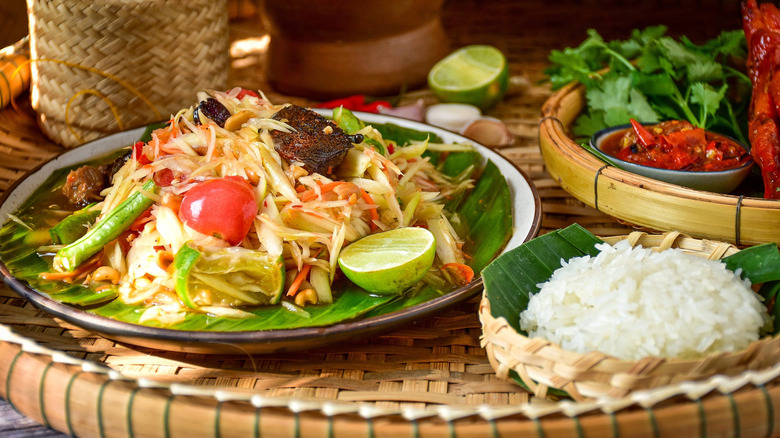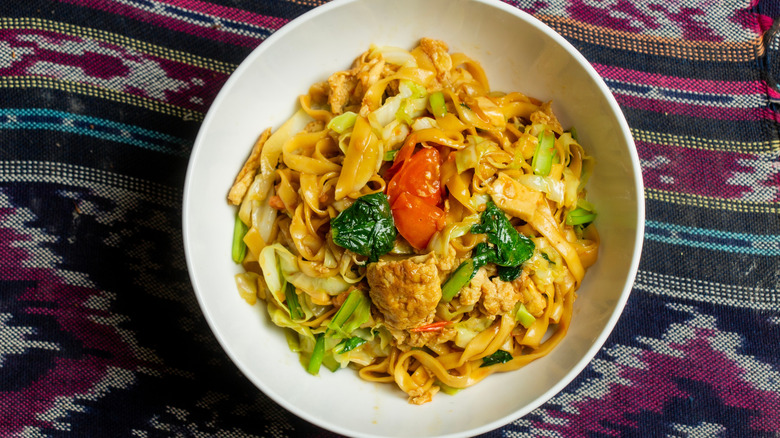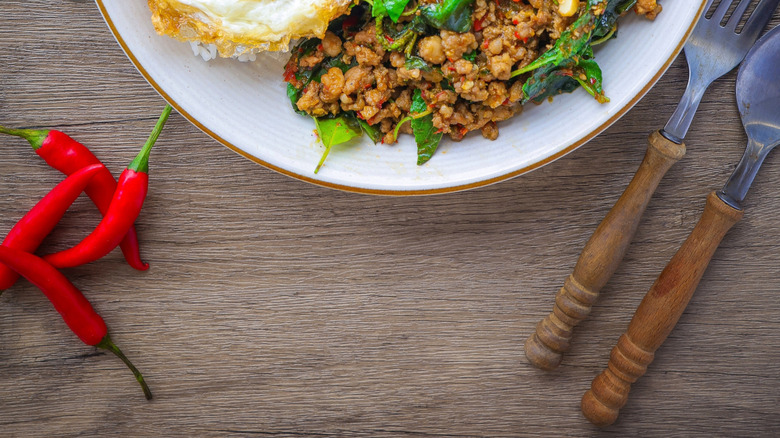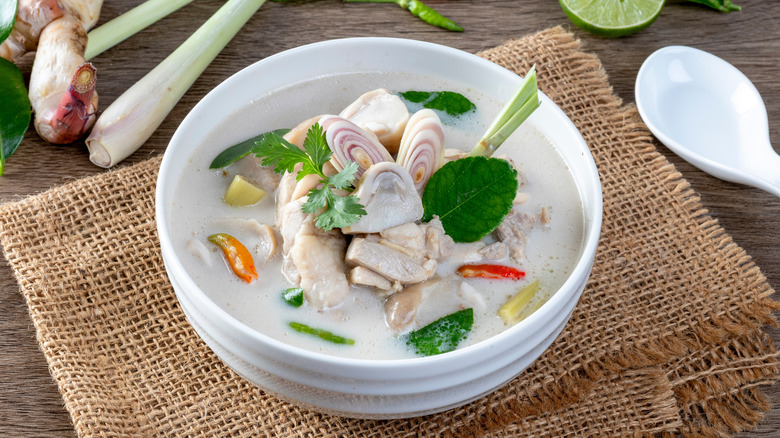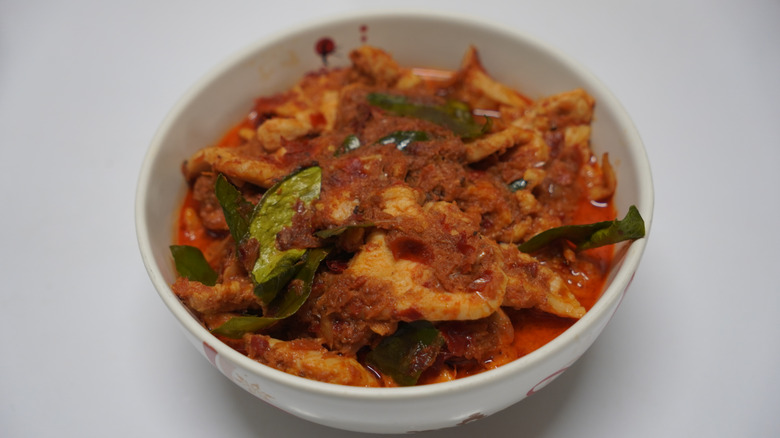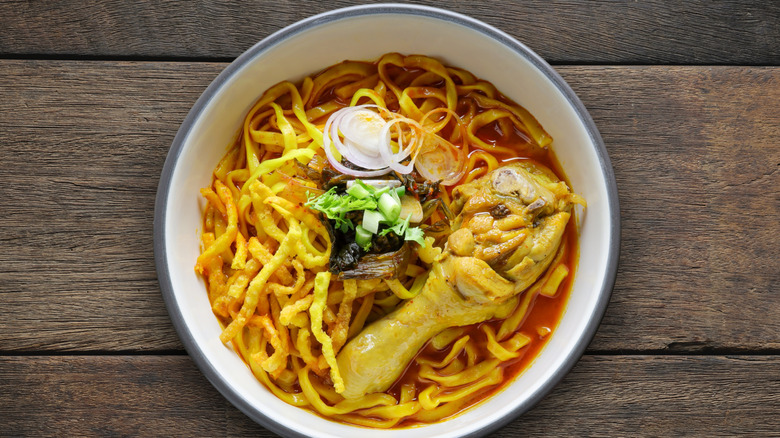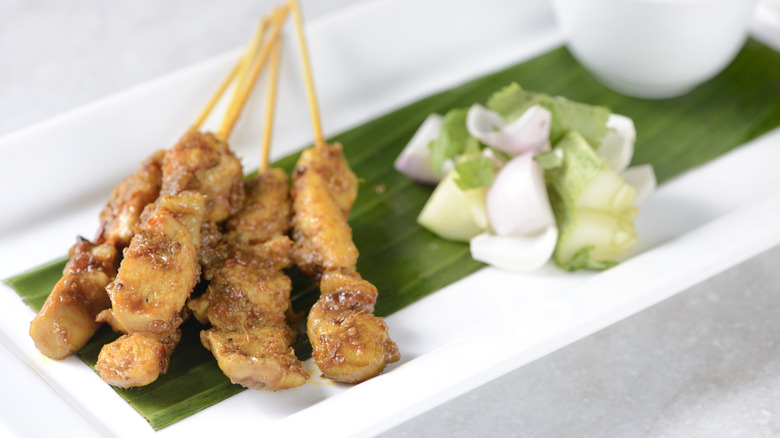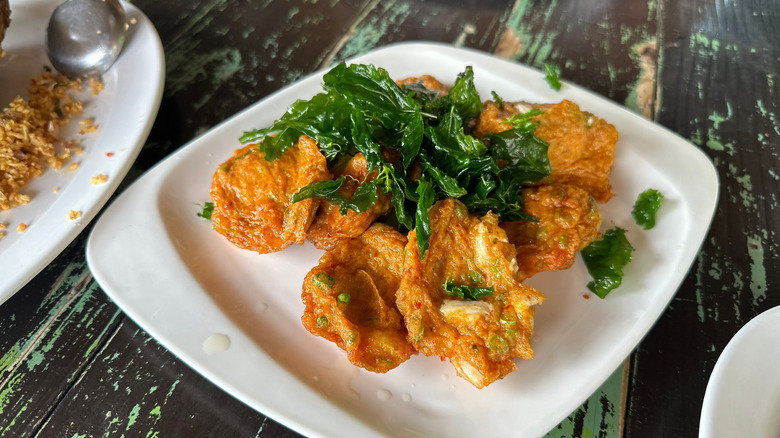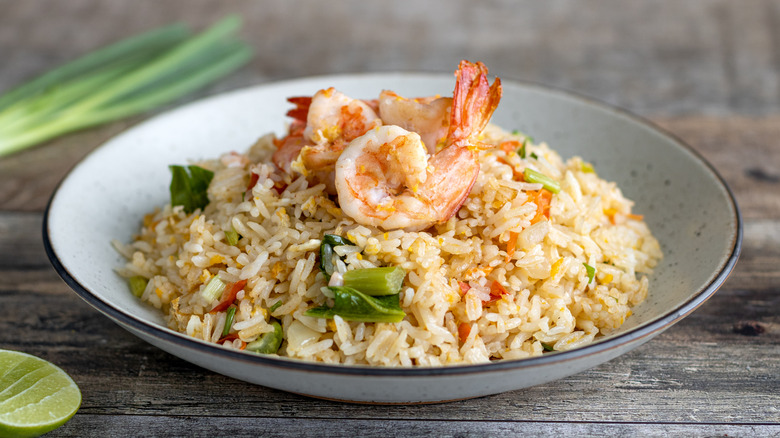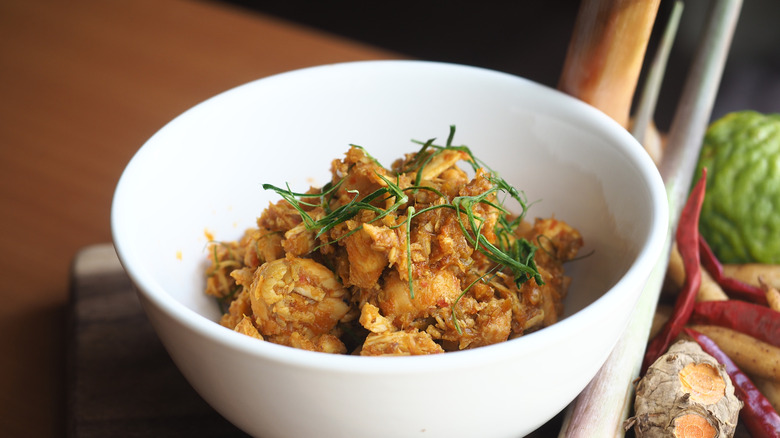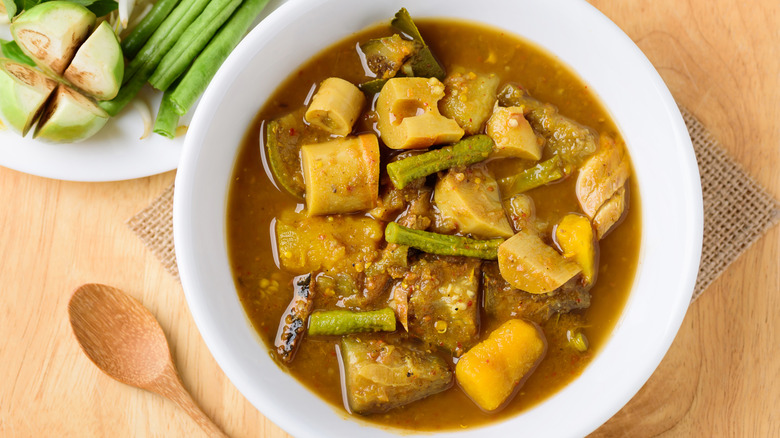14 Dishes You Should Be Ordering At A Thai Restaurant Beyond Pad Thai
If you haven't tried the vast expanse of delicious Thai cuisine, you're missing out on some of the top food. With its tasty peanut sauce, Pad Thai might be the first dish that you try. You may have even tried to make the best pad Thai at home using ingredients in your pantry. But while the noodle-based dish is delicious, expand beyond this staple to truly enjoy everything this culinary style has to offer.
Thai food is known for its saucy curries, fresh ingredients, and plentiful spices. We talked to top Thai chefs and recipe developers about the flavors that you can expect from Thai dishes and what you should look for on a menu if you want to try something new.
Natchaya Than, owner of Thailicious in Southlake, Texas, and Chuck Valla of Valla Table in NYC's Hell's Kitchen shared what they recommend to their restaurant patrons who are tasting Thai food for the first time or longtime fans who want to try something new. Recipe developers and culinary educators Maricel Gentile, author of "Maricel's Simply Asian Cookbook," and Jessica Randhawa at The Forked Spoon gave us tips on what flavors work well together in classic Thai recipes.
1. Panang curry
The delicious flavor of panang curry appeals to a lot of people and is a top recommendation for people new to Thai food from multiple experts that we talked to about dishes with wide appeal. I started the list with this delicious menu item since it's my go-to order and one that I actually prefer over pad Thai (although I will admit, it is a close race).
Thai curry is soupier than similar dishes from other countries, but it still has that signature balance of savory, aromatic, and slightly sweet flavors that you expect from a good curry. Panang curry can be served with chicken, pork, beef, or shrimp as well as rice.
Natchaya Than turns to panang curry for those who want something that is full of creamy, fragrant flavor thanks to the specific curry paste recipe. It uses coconut milk to deliver on the creaminess but the light red hue comes from the paste. Some restaurants add more (or less), which will impact the heat level and make the curry more intense or understated.
"I would definitely recommend panang curry to those trying out Thai food for the first time," says Than. "It's got a very unique flavor that most people love." Most Thai restaurants serve curries with a side of rice, but you can always ask for more if you want a less soupy bowl. You can also spoon the curry over the top of the rice, adding a smaller amount of liquid to suit your taste.
2. Gaeng pa
Also known as "jungle curry," gaeng pa is another popular choice for those who want something with a little bit more heat. It also tends to have a lot of vegetables, including baby corn, Thai eggplant, bell peppers, and more. Add your choice of meat to customize it for your taste and add some protein. Like panang curry, it has a nice flavorful broth made with coconut milk and curry paste as two of the most important ingredients.
"Thai curries are soupier than other curries because they aren't cooked for as long," says Natchaya Than. "They are usually packed with flavor too as we use a lot of different spices."
If you're worried about the level of heat, Thai food is good for customization. Maricel Gentile says that "the beauty of Thai (and Asian foods in general) is that you can choose your protein, such as chicken, shrimp, pork, beef, or tofu, or leave the protein out." She also recommends asking to "adjust the spice level to whatever you like." If you're cooking at home, this is easy to do by changing the amount of curry paste that you use. If you're at a restaurant, just let your server know how much heat you can handle.
3. Som tum
If you want something refreshing for lunch, som tum, also known as green papaya salad, is a top choice. This salad is full of fresh flavor, making it a great choice for a lighter meal that won't fill you up too much. As the name suggests, shredded green papaya makes up the base, but other vegetables fill things out. Tomatoes and long beans are plentiful, but it's the lime-based dressing that really brings the fresh, bright flavor.
"Som tum is bright, crunchy, and full of flavor," says Maricel Gentile. "It is made with shredded green papaya, tomatoes, lime, fish sauce, and chiles. It has a perfect balance of sweet, sour, salty, and spicy."
You can find it in Bangkok, one of the best food cities in the world, where tom sum is a popular street food. At restaurants, you may see it under the lunch or dinner menus as papaya salad or Tom Sum. For a larger meal, order it as a starter to get your taste buds excited about all of the new flavors.
4. Gaeng keow wan gai
You might recognize gaeng keow wan gai by its English descriptive name, Thai green curry. It uses a green curry paste along with creamy coconut milk and often has chicken, plus plenty of vegetables.
"Thai curry flavor comes from herbs like lemongrass, galangal, and kaffir lime," says Maricel Gentile. "Fresh herbs, not dried spices is the key to Thai curry." The green curry paste uses green chiles, which gives it heat plus the vibrant green color.
Like other Thai curries, you can get it with different types of protein and ask to adjust the spice if you don't want a super hot dish. Thai curries can be customized and each restaurant has its own unique take, even on traditional recipes like curries. Some load up with more vegetables while others lean heavily on the protein ingredients. If you're ordering this for the first time, serve it over rice to create a delicious soup-like dish.
5. Pad kee mao
Also known as drunken noodles, pad kee mao has plenty of garlic, which adds fragrant flavor, but also a bit of a kick at times. They're also loaded with Thai basil, which is different from other varieties in flavor and size. Add your choice of protein, such as chicken or beef. This noodle dish isn't as soupy as Thai curries and will need a fork rather than a spoon.
The story behind the name comes from the reputation of drunken noodles as the perfect dish to enjoy after a night of imbibing. The spice might even help you sober up — but it also makes a tasty lunch dish.
"I'd recommend any noodle dishes — pad Thai, pad see ew, pad kee mao — because they are nutritious, easy, fast and delicious," says Chuck Valla when asked what Thai food people should try if they're new to this culinary style.
Maricel Gentile recommends drunken noodles as the next spicy step beyond Thai green curry, calling it "another favorite among my students and guests who like a little more kick." Like other Thai dishes, you can ask to tone down the heat, so don't be afraid to give it a try even if you normally shy away from the spicier options. Just let your server know to make it on the mild side.
6. Pad krapow moo saap
Thai basil takes center stage in pad krapow moo saap stir-fry. It uses pork, Thai basil, and plenty of spices to come together in a super flavorful meat-based dish.
"It has just the right balance of savory, spicy, and herbal notes," says Maricel Gentile. She considers it a comfort food among Thai cuisine and counts it as one of her own personal favorites.
You can serve it on its own, but it commonly comes over rice, or with added protein such as a fried egg on top. The texture of this dish is much different than curries or noodles, so it makes a nice contrast to many of the fan favorites that you may have tried. It is also loaded with protein, especially when you add a fried egg, so it will keep you fueled up for the rest of your day. Some restaurants make giant portions and this dish works really well for leftovers. The flavors meld together even more and are super delicious the second time around.
7. Tom kha gai
On the other end of the texture spectrum from pad krapow moo saap stir-fry is tom kha gai, a soup loaded with a lot of flavor that features traditional Thai ingredients. For these reasons, Jessica Randhawa recommends it for newcomers trying Thai food for the first time.
"This comforting soup blends coconut milk, lemongrass, lime leaves, galangal, chicken, and mushrooms," says Randhawa. "It offers a wonderful introduction to Thai cuisine by balancing sweet, sour, salty, and mildly spicy flavors."
This soup is coconut milk-based, making it a creamy dish that is the perfect starter for your Thai meal or as the star of a light lunch. If you're not a fan of spicier foods, this sweet and creamy soup is the perfect answer. Even if you do like something with a little more of a kick, having a coconut milk-based soup nearby can help tame some of that heat and round out your meal.
8. Gaeng phed
The fresh ingredients in this red curry make it much different from curries from other countries, and it stands out even among Thai curries for its interesting flavor. The color and flavor comes mainly from the Thai red curry paste used in the recipe. But don't let the deep red flavor fool you into thinking that this dish will be too heavy.
"Unlike Indian curries, which are generally thicker and rely heavily on dried spices, Thai curries are lighter, smoother, and coconut milk-based — offering a brighter, fresher taste," says Jessica Randhawa.
Red curries use red chile peppers to get such a vibrant hue, which adds quite a bit of a kick. The addition of coconut milk helps cool things off, but you should still be ready for some spice in this dish. If you prefer something a little bit milder, just let your server know before ordering. They can adjust the intensity by switching up the ratio of paste to coconut milk. You can also use more of the veggies and proteins rather than the broth when ladling your curry over a bowl of rice to lean heavily into different elements of this dish.
9. Khao soi
Thai noodle dishes make fantastic lunch options because they tend to be on the lighter side and incorporate fresh ingredients. But they still provide plenty of fuel to see you through a busy afternoon.
Khao soi is a light lunch dish that hails from Northern Thailand. It is served with a rich coconut milk broth but it is not nearly as soupy as most curries, although it still includes some curry paste. "It's warm, comforting, and filling — ideal for midday dining," says Jessica Randhawa. If you want to make it into a heartier dish, add extra protein like chicken or beef.
Like most Thai food, you can get khao soi adjusted with different proteins and spice levels. Each restaurant adds different toppings, but things like crispy fried noodles and lime juice are very popular. This isn't one of the dishes with intense heat, just a nice deep, flavorful blend of spices and hearty noodles.
10. Chicken satay
Chicken satay is a classic Thai-style appetizer. In this dish, chicken is roasted and served on skewers, making for a fun presentation and delicious taste. You can put it alongside other Thai dishes, like green papaya salad or even soup to create a more balanced meal.
Jessica Randhawa likes chicken satay for a fun appetizer. It can be eaten without any utensils, served on a buffet table, and enjoyed on its own or with sauce. Ask for some peanut sauce to drizzle over the top or use as a dipping sauce for your satay. It's so popular with chicken satay that you might even see it called satay sauce on the menu.
Other countries have their own versions of satay (just check out its spot on our list of Indonesian dishes everyone should try at least once), but the blends of spices and flavors is unique to different culinary styles, regions, restaurants, and even chefs. Each puts a slightly different spin on the basic recipe, which includes skewering and grilling chicken.
11. Tod mun pla
You can find tasty Thai fish cakes at street vendors in Thailand or at your favorite Thai restaurant. If you're looking through the appetizer menu at a Thai establishment, look for the traditional name of tod mun pla.
These fish cakes are crispy on the outside but have plenty of salty, umami flavor. They typically come on a sharable plate and make a fantastic appetizer for a larger meal. Some restaurants like to add a little bit of Thai basil garnish while others really load them up. The fish cakes get a touch of spices before being fried, which incorporates these flavors well into every bite. They're not a light appetizer, like some of the soups or salads on our list, but instead bring a heartier start to your lunch or dinner.
Jessica Randhawa likes this dish to start, praising it for "tasty, approachable options that beautifully set the stage for your meal." If you're new to Thai food, you can't go wrong with this as your first foray into the culinary style.
12. Khao pad goong
If you're a seafood lover, khao pad goong is a shrimp rice that is the perfect place to start for people looking to branch out to new foods. It's made with traditional Thai flavors like chile, garlic, and plenty of seasonings.
Chuck Valla recommends it for those who are used to pad Thai as an alternative that's loaded with similar ingredients with a different twist, thanks to the shrimp and rice combo. While pad Thai is noodle-based, this dish relies on fried rice instead. But it brings a similar spice level and combination of bright herbs, savory spices, vegetables, and proteins. Many restaurants add egg to the mixture as well.
If you're used to other fried rice styles, this is another good dish to start with that showcases the difference when Thai-style spice blends are used. You can customize your protein, but not all restaurants are able to omit vegetables or other ingredients from the fried rice base. Of course, you can always try making it at home along with a Thai-inspired coconut and pumpkin soup.
13. Kua gling
If you like spicier dishes, try this pork stir-fry, kua gling. It's popular in the Southern regions of Thailand but you can get it at Thai restaurants all over the world. Like other spicy Thai dishes, it has a pretty good kick thanks to chile peppers used in the spice blend. That's tamed by other Thai flavors, however, like lemongrass and turmeric. It also includes a generous amount of fish sauce or paste to make it salty and umami-rich.
You can get this fried rice with minced pork or chicken. It's a fantastic one-bowl lunch or dinner. Chuck Valla recommends it for those who like that extra hit of a spicy kick in their Thai food. Even though it uses curry paste to bring in flavor, it isn't soupy like Thai curries. Chicken is commonly added but it's not the only protein that you can use for this dish.
14. Tai pla
Another spicier option that Chuck Valla points people to if they want to turn up the heat is tai pla. This curry has a unique flavor thanks to the addition of fish, plus tons of vegetables and spices. It is particularly salty because it uses a fermented fish-based sauce. You can get commercial versions to make this dish at home, but it is a bit harder to track down than other curry pastes. Trying it at a restaurant is a great option for those who want to sample something out of the ordinary.
Give fish curry a try, but be ready for some heat. While other Thai dishes incorporate creamy coconut milk to tame the spice, this soup uses water instead. The sauce in this curry is really strong and salty thanks to the fish ingredients, but also fish sauce. Overall, it has a very unique flavor that is perfect for those who have gone through all of the typical favorites on the Thai food menu and want to venture out beyond pad Thai.
